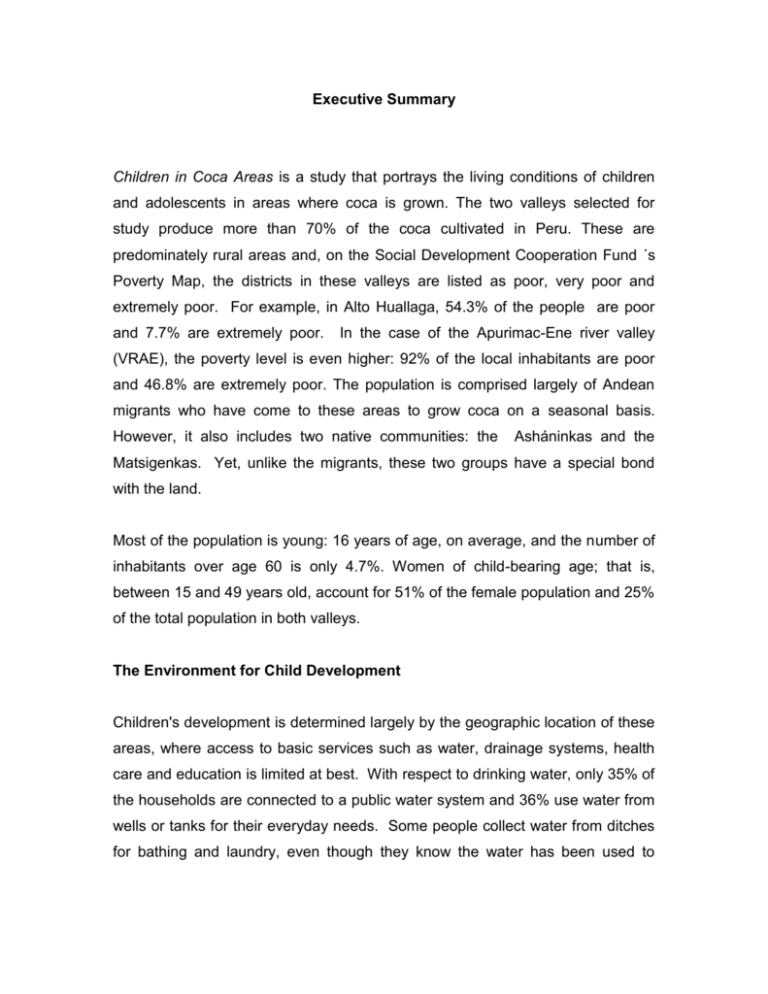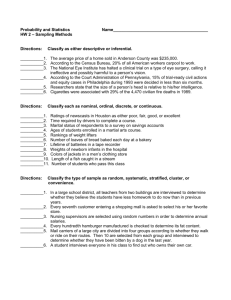Read the executive summary
advertisement

Executive Summary Children in Coca Areas is a study that portrays the living conditions of children and adolescents in areas where coca is grown. The two valleys selected for study produce more than 70% of the coca cultivated in Peru. These are predominately rural areas and, on the Social Development Cooperation Fund ´s Poverty Map, the districts in these valleys are listed as poor, very poor and extremely poor. For example, in Alto Huallaga, 54.3% of the people are poor and 7.7% are extremely poor. In the case of the Apurimac-Ene river valley (VRAE), the poverty level is even higher: 92% of the local inhabitants are poor and 46.8% are extremely poor. The population is comprised largely of Andean migrants who have come to these areas to grow coca on a seasonal basis. However, it also includes two native communities: the Asháninkas and the Matsigenkas. Yet, unlike the migrants, these two groups have a special bond with the land. Most of the population is young: 16 years of age, on average, and the number of inhabitants over age 60 is only 4.7%. Women of child-bearing age; that is, between 15 and 49 years old, account for 51% of the female population and 25% of the total population in both valleys. The Environment for Child Development Children's development is determined largely by the geographic location of these areas, where access to basic services such as water, drainage systems, health care and education is limited at best. With respect to drinking water, only 35% of the households are connected to a public water system and 36% use water from wells or tanks for their everyday needs. Some people collect water from ditches for bathing and laundry, even though they know the water has been used to produce cocaine and coca base. This poses a particularly serious problem for children, since their immune systems are not fully formed. The drainage system also has serious shortcomings. For example, 22% of the homes have no indoor toilets and only 5.5% are connected to a public sewer system. An alarming 60% use latrines and septic tanks. As to health services, 64% of the families go to a hospital or a nearby health centre for medical care. However, 20% resort to self-medication, either because they do not trust western medicine, lack the money for medical care, or because most health centres are located far from these communities. In these areas, obtaining a full education is a difficult and costly process. Completing high school often implies leaving home and moving to the district capital. Only 24.5% of the secondary schools are in these rural communities; 50% are in the district capitals. This contrasts with the number of primary schools in these rural communities: 72% in VRAE and 77.6% in Alto Huallaga. Going to the city everyday or living there is a major expense and many children do not complete their education for this reason. If they do, it is because they work on the weekends or during vacation to defray the cost. These difficulties are something parents consider when deciding whether or not to enrol their children in school. As to the make-up of families, the areas in question have a high rate of teenage pregnancy and marriage or cohabitation that begins during adolescence. For the most part, these are not long-term unions and second marriages or commitments are common. A high percentage of women are married (including second marriages) or living with a partner (60%), while the proportion of women who are separated, divorced or widowed is only 6%. This is related directly to the tendency for the father to support the family, not only his own children but also those from his partner's previous marriage or union, if there are any. . The violence perpetrated during the last two decades is an important aspect in the coca-growing valleys and has left its mark on the population. Drug trafficking and the terrorist activities of armed groups such as the Shining Path guerrillas (SL) and the Túpac Amaru Revolutionary Movement (MRTA) created a climate of fear and suspicion. As a result, the tendency now is towards negative and violent attitudes and reactions. When this behaviour is brought into the home, women and children fall victim to physical aggression. Thirty percent of the women interviewed for the study said they have been assaulted or beaten by their husbands or partners. The percentage was higher in VRAE (35%) than in Alto Huallaga (15.6%). Out of this 30%, an alarming 64% admitted to never having sought help in dealing with this situation. Having no one to turn to, being ashamed or wanting to avoid further beatings were the reasons given for not seeking help. As to children, corporal punishment is habitual as well. In fact, 61.4% of the parents interviewed consider it an effective corrective measure, one used both at home and at school. However, corporal punishment is not the only form of violence to which children are exposed; 25% of those interviewed said they know of girls and adolescents in their community who have been raped. Added to sexual abuse is the lack of psychological treatment and the possibility of reaching an agreement (financial or social) with the aggressor. The impunity with which these cases are handled is glaringly obvious. Domestic violence is prompted largely by alcoholism, which is very common among parents. In fact, 63% of the fathers and 34.3% of the mothers become intoxicated regularly. The children and adolescents in these communities are exposed to alcohol consumption at home, but also are under tremendous peer pressure to drink. In fact, 50% of those interviewed said they were aware of underage drinking, which begins early, at around 12 years of age. These abused and alcohol-consuming children will imitate the same violent behaviour they see in their environment. Children's Life Cycle There are four stages in a child's life cycle: gestation, infancy (the first three years of life), childhood (between four and 11 years of age) and adolescence. In the areas studied, early pregnancy is a frequent phenomenon: 21% of the teenage girls between 15 and 19 years of age have given birth or are expecting their first child. These figures are higher among the Asháninkas than among the Quechua-speaking and Spanish-speaking teens: 38.5% as opposed to 21.4% and 15.3%, respectively. Girls usually are taken out of school when they become pregnant. In fact, 40% of those interviewed believe it is better for these girls to leave school, so as not to be a bad example for others. All pregnancies require special care. Prenatal check-ups, iron supplements and vaccination against tetanus are extremely important, as they can prevent or avoid complications later on. However, more than 25% of the women who are now mothers said they had no regular medical check-ups during pregnancy. This problem is particularly serious among the indigenous population; neither the Asháninkas women (36%) nor the Quechua-speaking women (29%) who were interviewed had access to prenatal check-ups during pregnancy. As to iron supplements, 67% of the women who were interviewed said they took no supplements of any type, and 20% of the expectant mothers were not vaccinated against neonatal tetanus. This immunisation is essential. The precarious hygiene conditions found in the rural areas that were studied, coupled with the strong preference for home births (45%), which are attended by midwives (41%), threaten the health of both mother and child. They are exposed to a range of infections and diseases, and to contagion from HIV, AIDS or sexually transmitted diseases (STD). In fact, 15% of the deaths among women of childbearing age are due to STD and AIDS. Mother-child contagion is responsible for 90% of infection with HIV among children under 15 years of age. Acute diarrhoea diseases (ADD) and acute respiratory infections (ARI) are the most frequent health problems during childhood. More than 26% of the children above age five suffer from diarrhoea and 35% have an acute cough. On the other hand, the survey did reveal that education is regarded as a way to a better life. However, the higher the age group, the lower the enrolment rate. While 99% of the three-year-olds are enrolled in school, only 87% of the teenagers between the ages of fourteen and seventeen are still in school. Gradual desertion explains the high proportion of children who have fallen behind in school (48%). It is due to the cost implied in keeping a child in school (34%) and to child and teenage labour (18%). Yet, in spite of being a reason for dropping out of school, work is valued highly by the community. Besides generating additional income for the family, it is considered an educational experience and part of the learning process that prepares children for the future. Consequently, the percentage of children and adolescents who help out at home or work in the fields is high: almost 90%. In other words, children are subjected to a hard life and participate in social and economic activities as if they were adults. The characteristics of the environment in which children grow and develop have a direct impact on their life cycle. Because these are rural areas, the population is isolated from urban centres and consequently lacks access to adequate basic services and a higher level of education. Living conditions in the valleys where coca is grown are particularly hard for children. They are forced, without preparation, to struggle with problems particular to adults. Because of these complex circumstances and a lack of information, the rights of children and adolescents are violated constantly and quite easily. Children are deprived of their fundamental right to grow up in a healthy and protective environment where they can develop fully.





